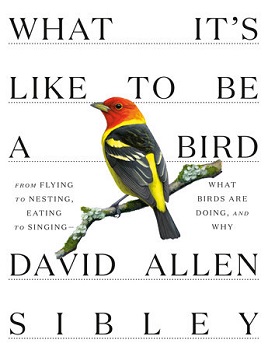What It’s Like to Be a Bird: From Flying to Nesting, Eating to Singing: What Birds are Doing, and Why by David Allen Sibley
One of the things I’ve enjoyed about being home so much during Washington’s Stay Home, Stay Healthy directive is setting up bird feeders and spending time birdwatching.
Resulting questions about bird behavior, nesting practices and communication led me to David Allen Sibley’s new book, What It’s Like to Be a Bird: From Flying to Nesting, Eating to Singing: What Birds are Doing, and Why.
When Sibley’s first bird guide was published in 2000, the birding world snapped to attention. For many birders, Sibley was the next generation to advance artist/birder Roger Tory Peterson’s body of work. Son of a Yale ornithologist, Sibley began drawing and researching birds at age 7 and just never stopped doing what he loves.
Sibley’s new work is not a typical guidebook, but rather the culmination of 15 years spent thinking about the most interesting and amazing things birds do and writing a series of richly illustrated short essays on these topics. There are multiple ways to read the essays, but Sibley recommends exploring them in a meandering path from one interest point to another. He makes this sort of dabbling curiosity easy by interlinking the essays through page number referrals.
Here are some of the things I learned in only the first few minutes with this amazing book: It is unknown why some birds hop and others walk. A robin can eat 14 feet of earthworms in a day. Sadly, most songbirds don’t survive their first year, and, once adult, have about a 50 percent chance of survival each year. Some birds have salt glands on their foreheads that function as extra kidneys and allow them to drink saltwater. Birds are able to sleep with one eye open, resting half of their brain at a time.
This is a large-format book so illustrations in the Portfolio of Birds can be as close to life-size as possible. For larger birds like pelicans, cormorants, or eagles, Sibley’s illustration is a life-size likeness of the bird’s head and neck or shoulders. This seems like a small detail, but it is just one of the factors that make these birds truly come alive on the page, and contributes to the reader having an experiential sense of the title’s promise: what it is like to be a bird.
Working on these essays confirmed for Sibley that birds’ instincts are not blind obedience to a DNA set of instructions, but are actually something much subtler and inviting of choices.
“A bird’s experience is far richer, complex, and ‘thoughtful’ than I’d imagined,” Sibley notes in the preface. This book truly gave me a sense of wonder about the myriad decisions birds make daily to survive, drawing on instinctual knowledge but also factoring in current conditions.
As the world’s bird population shrinks—the North American bird population has dropped 25 percent in the past 50 years—Sibley urges us to learn about the environmental challenges birds face in order to do all that we can to preserve the habitat of these amazing feathered creatures with whom we share the planet.
Lisa Gresham is the Collection Services Manager at the Whatcom County Library System. Visit https://www.wcls.org to place holds and find out about curbside hold pickup services; or give us a call at 360-305-3600 and we’ll happily place holds for you.
(Originally published in Cascadia Weekly, Wednesday, July 8, 2020.)

